Dan Dringenberg
A Conversation
Can you introduce yourself and tell us what you do here?
I’m Dan Dringenberg. I’ve been building machines since I was sixteen probably, maybe a little bit before that. And I’m here in Covina, California where we produce and make Dringenberg Tattoo machines.
How did you get your start in the tattoo industry?
Me and my little brother had a fascination with tattoos, and the first time we really encountered tattoos was noticing my Dad’s two tattoos, and we were fascinated. One of my older brother’s friends had his name tattooed on the web of his hand and we asked him how he did it, and he told us about using a needle and thread and ink. So me and my little brother used our bedroom closet as a little tattoo studio, my brother was in the first grade, two years younger than me, and I was in the third grade or whatever. He tattooed his name on his forearm, and he was like “your turn” and I said “ugh, Mom and Dad’s gonna kill you” and it’s been like that ever since. So my little brother was actually tattooed at the age of six.
There was a tattoo shop between my Mom’s house and my Grandma’s house, and we would drive past it all the time when I was a kid. I remember standing up on the seat and looking out at it, like wow. That’s the first place I worked. I got tattooed there – Fat George’s Tattoo Gallery. It was good, man.
Later on from there, I ended up working at Fat George’s, so my influences were from Scott Sterling to Paul Rogers, Percy Waters. Some of these people were doing phenomenal tattoos. Then there was Colonel Todd, and you had The Pike. The Pike was famous for tattooing.
A lot of good people came through there. Corey Miller, Mark Mahoney, Dick Warsocki, all kinds. There was some really good art that went through there – and there was some really bad art that went through there, too, but it was all part of the story. It was just all part of the smell, the sound, the magic.
When you walked in that shop, you knew you were in a tattoo shop. Everywhere you looked was flash. Everywhere. Not one open space. If there was an open space, a design was put in it. When you walk in, you smell the A&D, the green soap. You’d hear the constant buzzing of machines, and they had these nice roll top desks with sinks in ‘em, one on each side. Low ceiling fans, you’d walk in and it was just magic, you could tell. It was like home for me.
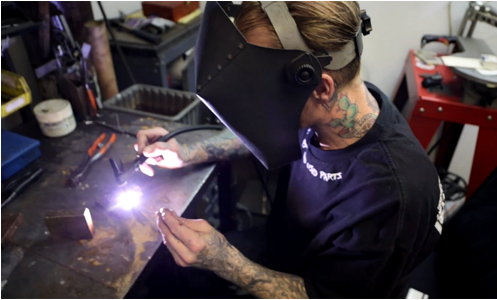
How did you actually start making tattoo machines?
got into fabricating – I have been working with machinery my entire life. My Dad had his Dad’s tools and there was an old 1920 or ‘25 machine lathe that I made leather belts for and I just started teaching myself how to use it as a little kid. Welding, you know, my Dad was a heavy equipment mechanic. We had all the best tools. And, man there wasn’t nothing we couldn’t do. My Dad used to always say, if you see it, someone made it. If someone made it, you can do it.
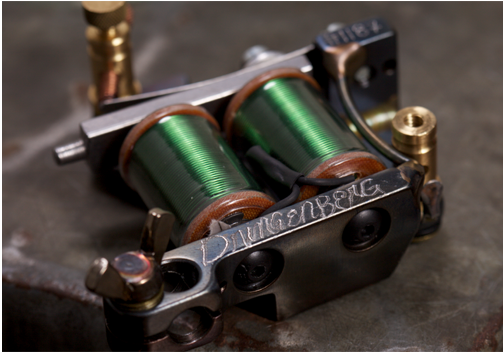
I started making tattoo machines at Fat George’s by chance actually. His machines would break down, and he’d just put ‘em in a safe or a toolbox, and they would stay there, and he’d get another one.
One day I started looking through ‘em. I got one that was broken to start working, and then the next day he took me to his house. We stopped by Sears and bought a rollaway toolbox. He had me put together machines in his garage, and there were two other rollaways in there. He told me to roll it in there, I rolled it in there, he sets it up like a little card table. He goes: “We’re gonna take the machines from this one, and put them in here.” They were full of all the machines that didn’t work. So I went through all these machines, and after I repaired all them, cleaning tubes and stuff, I started looking at the tubes. I thought, these tubes, they’re not finished, if someone spent their time they could make a better tube. So I told George that, and he goes “Really? Show me.”
So I went home and I spent two days making a tip on and old lathe. Never did stainless steel before. It was a rude awakening – a lot of learning curves on that, but I came back with the tube that ran great – held more ink, lasted longer.
And man, it was like shooting myself in the foot. Once I started selling them, people would buy ‘em and use ‘em for ten, fifteen years. They would never wear out. It’s good, on the one aspect, but on the manufacturing aspect, it isn’t that good, because once you got your client base and they got enough tubes, they’ve got enough tubes for their entire career. It was like a necessary evil. I didn’t even have any tubes myself.
It needs to have heart. It needs to be made with love. I think it needs to have the passion. ‘Cause passion can’t be substituted and it can’t be faked.
Was it just the time and the effort that you put in that made you really master machine building in the way that you have?
I studied tattoo machines the way I should have studied in school. I try to learn as much as I can and still keep the magic. The way it works is this: Tattoo artists are creatures of habit. People are on this rotary kick again. It seems like it never really goes away. Everybody’s saying coil machines are old technology. No, rotary is. Rotary was first. December 5th, 1892, Samuel L. O’Reilly took the tattoo machine patent. It was a rotary machine. It was proven, at the end of the 1800s - didn’t even last ten years – it was insufficient. It didn’t work right. It was faster than poking, but it wasn’t what it could be. And today, it still isn’t what it could be.
The more I learn about tattoo machines, it seems like the less I know. There’s so much more to learn. So I keep trying to push the envelope. That’s what this place is. It’s a learning facility. If I was by myself right now with the machines, without other people, I’d have no challenge, no feedback, no pushing. Same with tattooing - you get around people and you push the envelope, you feed, you learn and you keep challenging each other.
The team of people I have here have worked with me for many years, and we push each other. We’re good friends, and we work together. I try to create a family environment here, like we all eat together, we do things together. That’s the way it is. And in doing so, we get to know each other, and we bug each other. But this is my life, this is all I know, and it’s too late to turn around and do something else. We try to keep pushing the envelope so we can help other artists.
It’s like, one of the things I tell people when they come here: If you can’t appreciate what you’re doing, ‘cause you’re making a tool someone’s going to use to feed their family with, then you don’t need to be here, pretty much. Because that’s what we do. We build tools that people use to feed their families.
You’ve had some hard times along the way yourself. Do you feel like that gives you an appreciation for what other artists go through?
Yeah, there was a point in time when, I think my parents were just waiting for the phone call that I was dead, you know what I mean? I lived my whole first half of life trying to fucking die it seemed. Then when I fell into this, it was a little different.
I always tell people, I didn’t pick this career, it picked me. Two relationships later, that’s the only thing I still have that’s the same. I got a good daughter out of the first relationship. The second one I had sixteen wonderful years, I thought, but the business takes its toll. It wears them down.
It cost me two relationships, a relationship with my daughter, and this business is kind of like a drug for me. I’ll come in here and start working sometimes and I’ll forget to eat.
Because that’s what we do. We build tools that people use to feed their families.
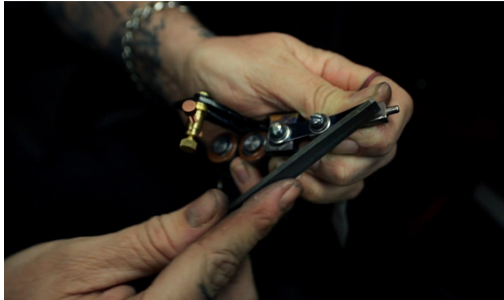
What do you think makes a good machine?
It needs to have heart. It needs to be made with love. I think it needs to have the passion. ‘Cause passion can’t be substituted and it can’t be faked. It can’t. Do you know what I mean? You can make stuff, everybody makes things – but if there’s not a passion for it – I think the passion is what makes it good. Because there’s a lot of stuff out there and if a person’s not passionate about it, it ain’t really gonna be great.
Can you tell us about how your machines are made?
I use a lot of cold rolled steel, brass – I’ve made machines out of just about every type of material there is. Like I said, there’s questions I’m still answering. Composites – I’ve done composite material, there’s a few one-offs out there that wow, I can’t, I remember when I did that, you know? There’s a lot of these machines I made, like people will see, have a different mark on the machine. Like I was in Oregon at a tattoo convention and this guy goes “hey I got this machine from you, it’s fucking awesome – but what the fuck does ‘burnt face’ mean?” and I start laughing and I told him man, that machine stuck to the side of my face when I was, I was grinding it, you know, buffing it and stuff. It was really hot, and my glove had a hole in it. I grabbed my glove with my teeth to try to pull it over the hole and the frame stuck to the side of my face. When I pulled it off, the skin was stuck to the side of it – so when I got done with it, I wrote ‘burnt face’ on it. You know what I mean, it’s like, that machine, it’s, it will work good forever, because what was put into it was passion – I didn’t stop.
That’s beyond amazing. Unbelievable, even. So how do you make your frames?
My frames are constructed in a three-part method. Like a prefab is what Paul Rogers would call ‘em. It is the best way to machine, or to build something, or to cast something. The definition of casting is a cheap way to mass produce a part. There are a lot of words in there I don’t like associated with my machines: Cheap and mass produced. Now, in the machining aspect, to machine something from a solid block, you lose about eighty percent of the material. What is left is highly stressed. Every time you cut metal, it stresses. You need to de-stress it – it makes the metal weak. That’s just the way it is.
Ideally in a machining process, when you’re machining machines, you want to keep as much metal as possible, just enough to, so, a three-part construction is the best way of doing a tattoo machine. Cost efficient, but no corners cut. However, it takes a couple of extra steps. Now, when we do our bottom plates, I think right now we’re in the middle of doing a run of four hundred and fifty. It will take us about two weeks. And that’s really putting work in, know what I mean, but there are no corners cut on them.
I could make them faster, however, eliminating a step, eliminating a bit of the passion. But to me, I do it this way because so far, it’s been pretty much the best way of doing it. I’ve made a lot of mistakes with different things. But each part of my machine is putting my own thought out – and I like when I get to a place where I’m stumped, because then it’s like the real engaging part of it kicks in: the sleepless nights, the writing notes, the studying, going back to the books – just trying to figure it out. So, it’s like, I’m constantly pushing the envelope, trying to, anyway.
And does it cost money? Sometimes yes, I come up with this idea – like, a guy who works for me came up with these coils and it gave birth to this one idea, and that idea went a little bit further. I took a little bit beyond scope to a point where the coils only lasted about six months before they were like springs – but I wouldn’t have known that until I got enough of them out and got the feedback, seeing that six months later.
However, for six months, I think I put five hundred machines out like that. And every one of my machines are guaranteed. I tell ‘em to send ‘em back, I’ll send you another one or I’ll change the coils out.
There’s been times when I’ve been at a convention, I see a machine, I know what’s wrong with it, I grab it and tell the guy take your pick. That’s what I do. But I needed the information because it gave birth to the next ones. I came up with the correct formula, now my coils have an inertia. What I did was, by creating this so that it comes down to the top of the coil – even at a lower speed or a lower power setting, it’s hitting with the same depth, the same follow-through. So it’s like, I made a mistake, owned it, and continued forward.
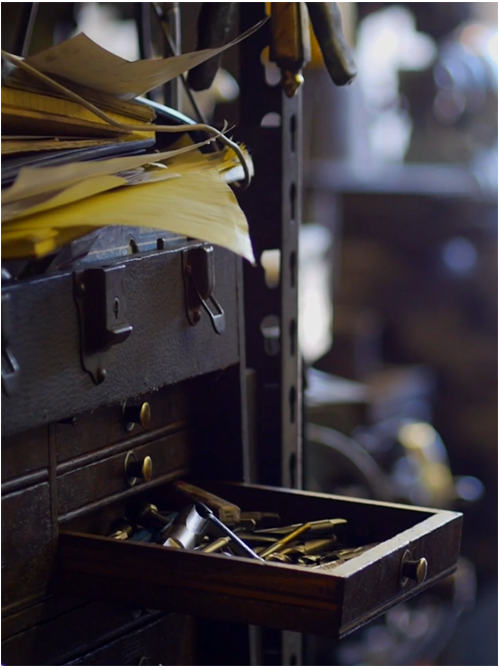
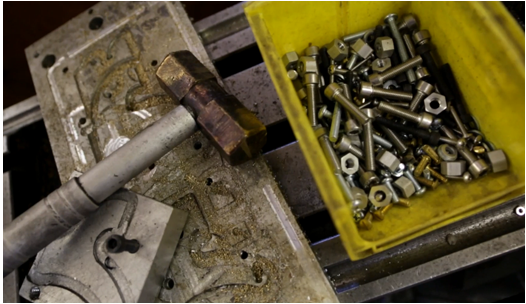
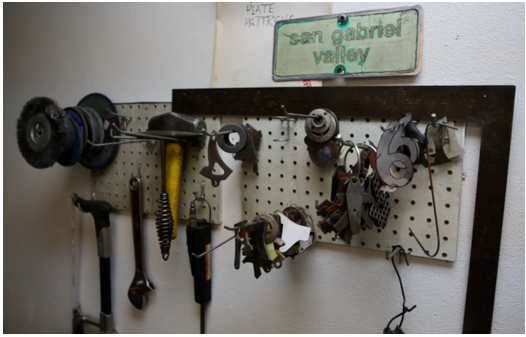
What is it about your machines that make them so sought after by so many great tattooers?
I like to think my machines are well thought out. I like to make ‘em bullet-proof. I’ve had machines where I’m tattooing and a customer goes to get up and accidentally cuts my clip cord, and the machine fell off the table, and man, I tried grabbing it, stabbed myself with the needle. It hits the ground and it just doesn’t work right no more. I try to build my machines where if they’ve hit the ground, you pick it up and you can still use it, because it’s an investment.
Like I said, my Dad was a heavy equipment mechanic. His tools were not second-rate. He used Snap-on or Mac. He used the best – and my Dad would break tools all the time. He’d take ‘em back to ‘em, they’d just give him another one. There wasn’t a question of where you bought it, or whether or not you have a receipt – if their name was on it, they stood behind it. Know what I mean?
And it’s like, that’s the kind of quality that I feel is lacking in our civilization today. Our civilization today is a consuming one, and that’s how our country has been downgraded. We don’t have product to sell, we only consume. When you ain’t got nothing left to sell, pretty soon, you’ve got empty pockets, so you’re gonna be downgraded. Until we get back a quality of merchandise that is sellable in an open market, our country will never get better and will only go down.
So in my way, I feel I’m staying true to the American way of doing things, when our country was unstoppable. As new as America was, people couldn’t win wars without our help. Because we were an industrial society – that is now gone. We’ve been taxed and we’ve been pushed right out of every aspect. You buy an American-made car, from China. It’s like, it’s like every one of these other countries that got tired of being third world are going to surpass us, because we’re lazy. I’m not afraid of hard work. I’ll work hard for my money, but I’ll also earn it. And that’s where I’m at with it. I think that’s the way tattooing should be. That’s what keeps it real.
What do you hope a tattooer who purchases a tattoo machine from you gets?
I hope they get a tool that they want to use every day that will only increase in value, not go down. My main goal is to keep it where it’s part of their retirement. I try to make machines that will increase in value. I hand-engrave for people, and some of them I’ve lost my ass on. Some of them I’ll do an engraving and not like it, and start it over again, and have to build the whole machine again, but that’s where the passion is. I try to give them machines that they will have for a long time, I’ll stand behind anything we make. If I put my name on it, it means something to me.
To me, I think the product should be smooth to the touch and pleasing to the eye – and work well. Not just one or the other. And if it doesn’t work well, the customer lets us know. It’s not working for them, and we work with them until it gets working the way they need it to work. That’s our goal. Stay real with it. We make our own armature bars. It’s all hand buffed, we tumble the frames after they’re all buffed and smooth to make them finish basically all the same. Nice and even. The corners all smoothed and rounded. But it’s still all the hand love that goes into each polishing and finishing of it.
The more I learn, the less I know. You have to. If you don’t learn every day, it’s a wasted day. And time is precious. I wasted lots of ‘em. And I don’t want to ever lose any more. Life’s too short. Nobody’s guaranteed a tomorrow, so what we gotta do is give an all today – and try to make a difference. That’s really where I’m at. I really want to leave everybody I meet, touched, inspired and motivated. I do, that’s my goal. That’s what wakes me up every morning, to try to make a difference. Am I? In my own mind, maybe I am. But you know what, I get up, and I do, I ask somebody how they are doing, I genuinely care. Know what I mean? It’s like, a friendly smile, it changes something.
That’s where I’m at today. That’s my goals, nowadays. Making a difference, one person at a time. Really am. And this shit right here, is gonna make a difference. Somebody’s gonna feed their family. In a weird way, I kinda take my position, I do my part.
What are your thoughts on the current culture of machine-building?
Um, wow. Not real good. The state people are in now – they’re in instant gratification mode. I’ve been told by people: “Yeah, I know it’s not Dringenberg, but this one is more affordable.”
My machines aren’t that much more money than what they are paying, but they haven’t even bothered to look. There’s a lot of my machines being knocked off right now in China – even my hand-engraved ones. You know, I mean, I was in Milan and I seen probably a thousand of them just sitting right there and I just was like – I couldn’t even talk. I ended up just blown away, because those are my machines. Know what I mean?
There’s a whole generation of people that don’t care anymore, and I don’t know what it is. A friend of mine told me, he goes man, I’m part of that Google generation and I don’t want to be. I want to learn the old way. I want to learn the real way. Anybody can go to Google and pull it up. I was taught a long time ago, in fact, even Da Vinci said any art is only as good as your reference, and your means of accessing that reference.
So the best tattoo artists were the ones that didn’t hoard their money – they sank their money back into learning. ‘Cause they wanted to answer the questions they had in their mind and they kept pushing the envelope. They spend their money – thousands and thousands of dollars on books. When I go to a tattoo shop, the first thing I do is look at their book collection. I look through their book collection and I learned a good way of getting reference was to look at the books that have tons of pieces of paper stuck in them. That’s a highly used book. More valuable than the one you see that looks great but never been cracked. That one is a bad investment.
I started studying that stuff. And that’s the way I studied tattoo equipment, same way. And when I give these seminars to people, I always tell ‘em: Don’t take everything I say as gold. Find it yourself. That’s how I found my information. If you find something different, share it with me. That’s the only way we’re going to get to the next level is with information and sharing. Once everybody gets to one level, the next questions we’re answering are the ones we’re writing.
That’s where I’m trying to go. That’s why I brought this together here, you know, a learning facility, where tattoo artists and people who are passionate have a place to share their passion. And it seems to be working, you know. That’s the one thing with passion, even if I wasn’t getting paid – I’d still be doing it.
To sum up, what is the machine building oath which you live by?
I promise to make the best quality stuff that can be done without corners being pulled. The crew that I assembled here, they think the way I think. However, I’ve been surprising them lately. I’ve been surprising them lately with my temper being as mellow as it is. I think the latest chain of events in my life have changed my outlook a little bit on life. Where now, instead of fighting right away or being combative against something, now I look at it through a different set of eyes, try to approach things a little bit differently. The old way of tattooing and working on stuff like that didn’t work.
Now I feel there’s time, the new generation is here. We’re not gonna stop ‘em, but there is a way to educate ‘em. And it’s not through trying to blackball or anything like that, because that won’t happen. I think the best way now is to try to find the ones that are worthy and that will keep it alive. Try to pass some of it to them so that the old doesn’t get completely filtered out. That way a few generations later on, or from them, there’ll be a few still who’ll seek out that old way, and it won’t get lost.
I have been living in Amsterdam and working at the Amsterdam Tattoo Museum for the past year and a half, going back and forth, and setting the same business up there as well. I have been spending more time in Amsterdam than I have been here lately, and I have been here now for two months, but going back and forth still. They got a ship out there called ‘The Amsterdam’ and it’s a reproduction of the original ship. The original ship took a hundred men, six months to build. The reproduction took three hundred men, six years, with the same tools. Now, it shows you what’s happening. The craftsmanship is being changed. I don’t want that to happen in this business – because that was an eye opening thing for me to see that
I think this still needs to be handed down to some people. I use machinery to do it, but I still use machinery that takes heart to run.

